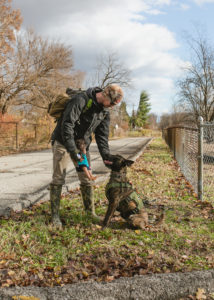All dogs are capable of tracking, but drive is necessary for the dog to track. This creates a big debate about how a dog should track. Should the dog be on or off the leash, nose to the ground, or nose in the air? There are many things to consider such as the time of day, temperature, wind, terrain, season and many other factors.
We do not believe in making the dog search outside the dog's natural way. When, was the last time a bad guy or missing person was dragging hot dogs tied to their shoes, dropping dog food along the way, or dragging their feet to exaggerate the path? We provide training using realistic scenarios.
There are many functions that a dog can perform under the basics of tracking. Tracking in its simplest form refers to a dog's ability to track a specific scent. Trailing is a dog's ability to follow the specific scent, but may or may not be the exact path. Search and Rescue refers to dogs that detect human scent.
There are different types of tracking dogs, and the differences are listed below.
Air Scent Dog: This dog finds lost people by picking up traces of human scent that are drifting in the air, and looks for the "cone" of scent where it is most concentrated.
Trailing Dog: This dog finds lost people by picking up traces of human scent that is normally left near the ground, so the trailing dog will frequently have its nose to the ground. The only dog truly bred to do this is the Bloodhound.
Tracking Dog: A tracking dog is trained to follow the path of a certain person. This dog is usually worked in a harness and on a leash. This type of dog is effective when pursuing an escaped criminal.
Disaster Dog: A disaster dog is trained to find human scent in unnatural environments including; collapsed structures and areas affected by tornadoes, earthquakes, and other disasters. This dog is trained to work on unstable surfaces and in small, confined spaces and other settings not usually found in the wilderness.
Cadaver Dog: A cadaver dog reacts to the scent of a dead human. The dog can be trained for above ground and buried cadaver searches. Although many dogs have the potential to detect human scent whether dead or alive, the cadaver dog is trained to locate only human remains.
The list could go on and on, depending on how you want to categorize the dog and whose philosophy of training you buy into. In the end, the goal should all be the same: locate the human scent.

